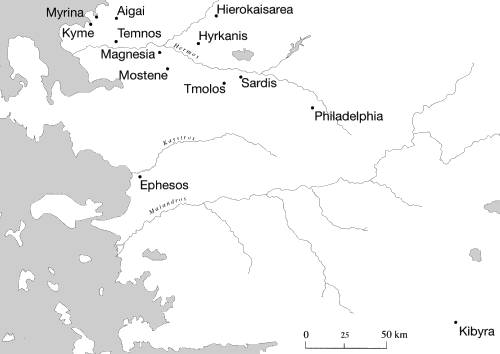The worship of the deified Emperors could take place in monumental temples, in Puteoli for example in the Templum Divi Pii for Antoninus Pius, mentioned in an inscription from 187 AD (EDR165202). Since the reign of Augustus the Imperial cult was also linked to the wards (vici) of Rome, where the Lares Augusti, the household deities of the Emperor, were worshipped. These deities were fused with the old Lares Compitales, who had their place at crossroads (compita). Magistri and ministri vici were in charge of the cult. The cult is also attested in other cities, and in the late 20th century a shrine was excavated underneath Pozzuoli.
The shrine has a kind of vestibule, on the walls of which large red roses are painted. In the shrine itself is a masonry altar. On the wall behind the altar are two snakes between two trees, probably laurel trees, attributes of the god Apollo with whom Augustus associated himself. Above the snakes are three figures, preserved badly: the Genius of the Emperor, flanked by two Lares, among red roses.

Left. Painting of snakes and altar.
De Vincenzo 2008, fig. 2.
Top. Plan of the shrine.
De Vincenzo 2008, fig. 7.On the lateral walls are the Twelve Gods, six on each wall: on the left wall Diana, Apollo, Minerva, Jupiter, Juno and Neptunus; on the right wall Mercurius, Ceres, Vulcanus, Venus, Mars and Bacchus.
Six of the twelve gods, on the left wall.
Photo: ArcheoFlegrei.On the wall with the entrance of the shrine are two depictions of Hercules. The paintings have not been dated accurately, they belong somewhere in the first two centuries AD.
Depictions of Hercules.
Photo: De Vincenzo 2008, fig. 12.The Imperial cult was particularly dear to the Augustales, a priestly college, overwhelmingly made up of freedmen. In 1693 a large marble base was found in Pozzuoli, at an unspecified location, for a statue of Tiberius. It is decorated with personifications of 16 cities in Asia Minor. The base and statue were the work of the Augustales, who in this way, in 30 AD, thanked Tiberius for coming to the aid of these cities, most of which had been struck by a tremendous earthquake in 17 AD, one (Kibyra) by a smaller one in 23 AD. The events of 17 AD are recounted by Tacitus:
Eodem anno duodecim celebres Asiae urbes conlapsae nocturno motu terrae, quo inprovisior graviorque pestis fuit. Neque solitum in tali casu effugium subveniebat in aperta prorumpendi, quia diductis terris hauriebantur. Sedisse inmensos montis, visa in arduo quae plana fuerint, effulsisse inter ruinam ignis memorant. Asperrima in Sardianos lues plurimum in eosdem misericordiae traxit: nam centies sestertium pollicitus Caesar, et quantum aerario aut fisco pendebant in quinquennium remisit. Magnetes a Sipylo proximi damno ac remedio habiti. Temnios, Philadelphenos, Aegeatas, Apollonidenses, quique Mosteni aut Macedones Hyrcani vocantur, et Hierocaesariam, Myrinam, Cymen, Tmolum levari idem in tempus tributis mittique ex senatu placuit, qui praesentia spectaret refoveretque. Delectus est M. Ateius e praetoriis, ne consulari obtinente Asiam aemulatio inter pares et ex eo impedimentum oreretur. That same year twelve famous cities of Asia fell by an earthquake in the night, so that the destruction was all the more unforeseen and fearful. Nor were there the means of escape usual in such a disaster, by rushing out into the open country, for there people were swallowed up by the yawning earth. Vast mountains, it is said, collapsed; what had been level ground seemed to be raised aloft, and fires blazed out amid the ruin. The calamity fell most fatally on the inhabitants of Sardis, and it attracted to them the largest share of sympathy. The emperor promised ten million sesterces, and remitted for five years all they paid to the exchequer or to the emperor's purse. Magnesia, under Mount Sipylus, was considered to come next in loss and in need of help. The people of Temnus, Philadelpheia, Aegae, Apollonis, the Mostenians, and Hyrcanian Macedonians, as they were called, with the towns of Hierocaesarea, Myrina, Cyme, and Tmolus, were, it was decided, to be exempted from tribute for the same time, and someone was to be sent from the Senate to examine their actual condition and to relieve them. Marcus Aletus, one of the ex-praetors, was chosen, from a fear that, as an ex-consul was governor of Asia, there might be rivalry between men of equal rank, and consequent embarrassment. Tacitus, The Annals II,47,1. Translation A.J. Church and W.J. Brodribb. Below the personifications are the names of the cities, unfortunately damaged. There has been quite some debate over the correct identification, made more complicated because Tacitus mentions only 12 cities. Sardis and Magnesia flank the dedicatory inscription on the front.
Ti(berio) CAESARI DIVI
AVGVSTI F(ilio) DIVI
IVLI N(epoti) AVGVSTO
PONTIF(ici) MAXIMO CO(n)S(uli) IIII
IMP(eratori) VIII TRIB(unicia) POTESTAT(e) XXXII
AVGVSTALES
RES PVBLICA
RESTITVIT
[tyrr?]HENIA [sardes?] [p?]ELOPON[nesos?]
[Magnes]IA PHILADELPHEA [tm]OLVS
CYME [te]MNOS CIBYR[a] MYRINA
EPHES[os] APOLLONIDEA H[yrcanis]
[moste]NE [Aegai] H[ieroc]AESAR[ea]
Inscriptions on the front and below the personifications.
CIL X, 1624; Weisser 2008, 120-122.Map with cities struck by the earthquakes.
Image: Weisser 2008, Abb. 1.The base must have been inspired by a monument in Rome that was erected by the Asian cities on the Forum of Caesar, next to the Temple of Venus Genetrix. It consisted of a colossal statue of Tiberius, and of statues of personifications of the cities next to it (Phlegon of Tralles, De Mirabilibus XIII). It is not surprising that the Augustales wanted to thank the Emperor in this crucial port city with its Greek background. There were of course commercial relations with the area, and many Augustales may have had a Greek-speaking background.
The front of the base. The last two lines might have been added later.
Archaeological Museum, Naples. Image: Weisser 2008, Taf. 48.
The back and left side of the base.
Archaeological Museum, Naples. Image: Wikimedia.
The base next to the Duomo in 1781.
Image: Weisser 2008, Abb. 3.